The global network simulator software market is projected to reach USD 491.8 million by 2035, recording an absolute increase of USD 189.9 million over the forecast period. The market is valued at USD 301.9 million in 2025 and is set to rise at a CAGR of 5.0% during the assessment period. The overall market size is expected to grow by nearly 1.6 times during the same period, supported by increasing demand for advanced telecommunications infrastructure and intelligent transportation systems worldwide, driving demand for specialized simulation platforms and increasing investments in network testing and traffic generation applications globally. Complex licensing requirements and integration challenges may pose obstacles to market expansion.
Network simulator software represents specialized computer programs designed to model network behavior, test configurations, and analyze performance characteristics without requiring physical hardware infrastructure. These applications enable network engineers to create virtual environments that replicate real-world network conditions, allowing comprehensive testing of protocols, security measures, and traffic patterns before deployment. Software packages integrate multiple simulation engines supporting diverse networking standards including TCP/IP, OSPF, BGP, and wireless protocols across various network architectures.
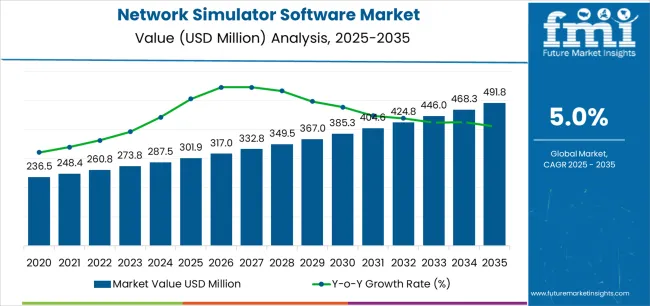
Leakage injection capabilities form a critical component of network simulation platforms, enabling engineers to identify vulnerabilities and test security measures under controlled conditions. These functions simulate various attack vectors, including denial-of-service attempts, packet interception, and protocol manipulation, providing comprehensive security assessment capabilities. Advanced platforms incorporate automated vulnerability scanning, penetration testing modules, and threat modeling systems that help organizations identify potential weaknesses before network deployment.
Traffic generation modules within simulator software create realistic network loads for performance testing and capacity planning purposes. These components generate various data patterns, including bulk transfers, real-time communications, and multimedia streams, enabling comprehensive evaluation of network behavior under different usage scenarios. Load testing capabilities support both steady-state and burst traffic patterns, allowing engineers to assess network resilience and identify potential bottlenecks.
Safety testing functions ensure network configurations meet reliability and performance standards required for critical applications. These modules verify redundancy mechanisms, failover procedures, and emergency response protocols across different network topologies. Testing frameworks support compliance verification for industry standards including ISO 27001, NIST cybersecurity framework, and telecommunications regulatory requirements.
Educational applications leverage network simulator software for training purposes, providing hands-on learning experiences without requiring expensive physical equipment. Academic institutions utilize these platforms to teach networking concepts, protocol behavior, and security principles through interactive simulations. Professional training programs employ simulators for certification preparation and skills development in network design, troubleshooting, and management.
Between 2025 and 2030, the network simulator software market is projected to expand from USD 301.9 million to USD 390.5 million, resulting in a value increase of USD 88.6 million, which represents 46.7% of the total forecast growth for the decade. This phase of development will be shaped by rising demand for telecommunications infrastructure testing and intelligent transportation system applications, product innovation in traffic generation technologies and safety testing systems, as well as expanding integration with cloud-based simulation platforms and enterprise network management applications.
From 2030 to 2035, the market is forecast to grow from USD 390.5 million to USD 491.8 million, adding another USD 101.3 million, which constitutes 53.3% of the overall ten-year expansion. This period is expected to be characterized by the expansion of advanced security testing applications, including sophisticated vulnerability assessment tools and automated penetration testing systems tailored for specific network requirements, strategic collaborations between simulator providers and telecommunications companies, and an enhanced focus on artificial intelligence integration and cloud-native simulation protocols.
| Metric | Value |
|---|---|
| Market Value (2025) | USD 301.9 million |
| Market Forecast Value (2035) | USD 491.8 million |
| Forecast CAGR (2025-2035) | 5.0% |
The network simulator software market grows by enabling telecommunications companies and enterprise organizations to optimize network designs while accessing specialized testing capabilities without substantial physical infrastructure investment. Network operators and system integrators face mounting pressure to deploy advanced telecommunications systems and intelligent transportation networks while managing complex security requirements, with high-performance simulation platforms typically providing 40-60% performance enhancement compared to traditional testing methods, making advanced software-based solutions essential for competitive market positioning. The telecommunications industry's need for comprehensive testing capabilities and application-specific security validation creates demand for comprehensive simulator solutions that can provide superior accuracy, maintain consistent performance standards, and ensure reliable operation without compromising network security or operational effectiveness.
Government initiatives promoting telecommunications infrastructure modernization and intelligent transportation development drive adoption in network planning, system integration, and security testing applications, where simulation quality has a direct impact on deployment success and long-term operational efficiency. However, complex licensing constraints during large-scale implementation projects and the expertise requirements for advanced simulation integration may limit accessibility among smaller telecommunications companies and developing regions with limited technical infrastructure for sophisticated network testing systems.
The market is segmented by type, application, and region. By type, the market is divided into leakage injection, traffic generation, safety test, and other categories. Based on application, the market is categorized into telecom and communications, intelligent transportation, industrial, and other applications. Regionally, the market is divided into Asia Pacific, North America, Europe, and other key regions.
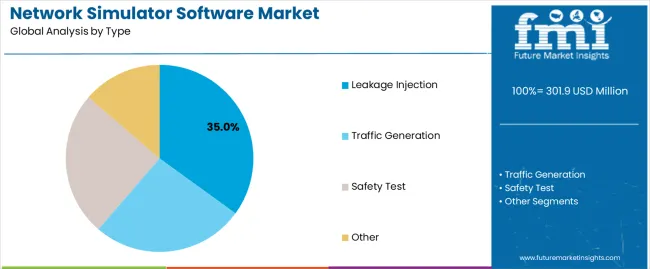
The leakage injection segment represents the dominant force in the network simulator software market, capturing approximately 35% of total market share in 2025. This established testing category encompasses solutions featuring advanced vulnerability assessment processes and specialized security testing applications, including high-performance penetration testing characteristics and enhanced threat modeling capabilities that enable superior security validation and network hardening outcomes across all telecommunications applications. The leakage injection segment's market leadership stems from its proven testing capabilities, with solutions capable of addressing diverse security requirements while maintaining consistent accuracy standards and assessment effectiveness across all network environments.
The traffic generation segment maintains substantial market presence, serving specialized applications that require comprehensive load testing with particular performance characteristics for network capacity planning and optimization. The safety test segment provides critical reliability verification for mission-critical network applications while offering sufficient validation capabilities to meet regulatory and compliance demands. Other testing categories collectively serve specialized simulation requirements across various network testing applications.
Key type advantages driving the leakage injection segment include:
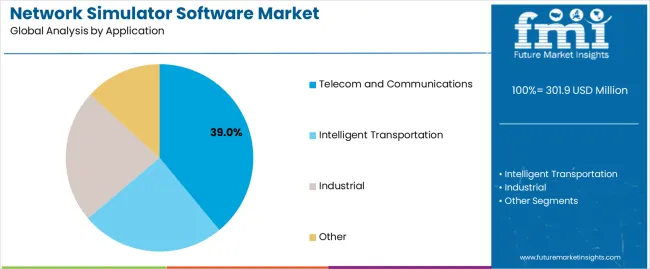
Telecom and communications applications dominate the network simulator software market with approximately 39% market share in 2025, reflecting the critical role of simulation testing in supporting advanced telecommunications infrastructure and network deployment requirements worldwide. The telecom and communications segment's market leadership is reinforced by increasing 5G deployment trends, network modernization requirements, and rising needs for comprehensive testing capabilities in telecommunications operations across developed and emerging markets.
The intelligent transportation segment represents the second-largest application category, capturing substantial market share through specialized requirements for traffic management systems, autonomous vehicle networks, and smart infrastructure applications. This segment benefits from growing smart city integration demand that requires specific simulation requirements, safety validation standards, and performance optimization protocols in transportation markets.
The industrial segment serves manufacturing networks, process control systems, and industrial automation applications across various operational sectors. Other applications encompass educational institutions, research facilities, and specialized network testing requirements.
Key market dynamics supporting application growth include:
The market is driven by three concrete demand factors tied to telecommunications infrastructure outcomes. First, 5G network deployment and telecommunications modernization create increasing demand for advanced simulation platforms, with testing capability requirements growing 15-25% annually in major telecommunications markets worldwide, requiring comprehensive software infrastructure. Second, government initiatives promoting smart city development and intelligent transportation systems drive increased adoption of network simulation solutions, with many countries implementing digital infrastructure programs and regulatory frameworks for telecommunications advancement by 2030. Third, technological advancements in cloud computing and artificial intelligence enable more efficient and effective simulation methods that improve testing accuracy while reducing operational costs and deployment complexity.
Market restraints include complex licensing requirements and integration costs for advanced simulation platforms that can challenge market participants in developing compliant testing capabilities, particularly in regions where regulatory pathways for telecommunications testing remain evolving and uncertain. Technical complexity of advanced simulation systems and security validation requirements pose another challenge, as network simulators demand sophisticated modeling methods and accuracy controls, potentially affecting implementation costs and operational efficiency. Skilled personnel constraints from limited simulation expertise across different regions create additional operational challenges for organizations, demanding ongoing investment in training programs and technical support systems.
Key trends indicate accelerated adoption in Asia-Pacific markets, particularly China and India, where telecommunications expansion and infrastructure development drive comprehensive network simulation adoption. Technology integration trends toward cloud-based simulation platforms with enhanced artificial intelligence characteristics, advanced security testing applications, and integrated performance monitoring solutions enable effective testing approaches that optimize validation efficiency and minimize deployment risks. The market thesis could face disruption if advances in automated testing technologies or changes in telecommunications standards reduce reliance on traditional simulation applications.
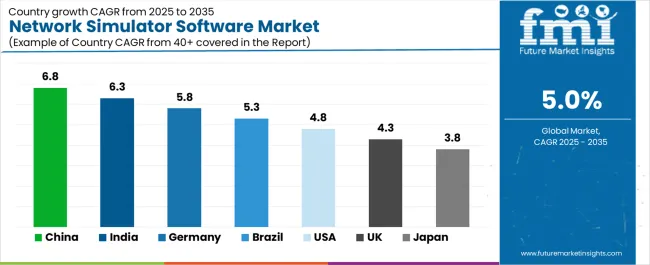
| Country | CAGR (%) |
|---|---|
| China | 6.8% |
| India | 6.3% |
| Germany | 5.8% |
| Brazil | 5.3% |
| USA | 4.8% |
| UK | 4.3% |
| Japan | 3.8% |
The global network simulator software market is expanding steadily, with China leading at a 6.8% CAGR through 2035, driven by massive 5G infrastructure deployment, smart city initiatives, and comprehensive telecommunications modernization programs. India follows at 6.3%, supported by digital transformation programs, telecommunications sector growth, and government technology initiatives. Germany records 5.8%, reflecting advanced industrial applications and precision engineering requirements. Brazil advances at 5.3%, leveraging telecommunications infrastructure development. USA grows at 4.8%, anchored by enterprise network security and advanced testing capabilities. UK posts 4.3%, focusing on telecommunications innovation, while Japan grows at 3.8%, emphasizing technology precision and quality standards.
China demonstrates the strongest growth potential in the network simulator software market with a CAGR of 6.8% through 2035. The country's leadership position stems from massive 5G infrastructure deployment, government-backed smart city programs, and comprehensive telecommunications regulations driving the adoption of advanced network simulation solutions. Growth is concentrated in major technology centers, including Beijing, Shanghai, Shenzhen, and Guangzhou, where telecommunications companies and technology firms are implementing sophisticated simulation platforms for enhanced network testing capabilities and deployment optimization. Distribution channels through technology integrators and telecommunications equipment providers expand deployment across infrastructure projects and system integration initiatives. The country's Ministry of Industry and Information Technology provides policy support for telecommunications technology advancement, including comprehensive simulation capability development.
The Chinese market demonstrates distinctive application patterns, with telecom and communications commanding 45.0% market share, reflecting the country's massive telecommunications infrastructure investments and 5G deployment programs. Intelligent transportation applications account for 25.0% market share, while other applications capture 30.0%, indicating strong diversification across industrial and smart city projects. Technology deployment focuses on advanced traffic generation systems and integrated security testing protocols that meet Chinese telecommunications standards while addressing specific network performance requirements.
Key market factors:
In major telecommunications and technology centers including Mumbai, Delhi, Bangalore, and Hyderabad, the adoption of comprehensive network simulation solutions is accelerating across infrastructure projects and digital transformation initiatives, driven by telecommunications sector modernization and government digitalization programs.
The market demonstrates strong growth momentum with a CAGR of 6.3% through 2035, linked to comprehensive digital infrastructure development and increasing focus on advanced network testing solutions. Indian companies are implementing sophisticated simulation platforms and testing systems to enhance network performance while meeting growing demand in expanding telecommunications and smart infrastructure sectors. The country's digital development initiatives create continued demand for simulation solutions, while increasing emphasis on network security drives adoption of advanced testing systems.
The Indian market shows specialized application distribution, with telecom and communications applications representing 42.0% market share, supported by the country's rapid mobile network expansion and fiber optic infrastructure development. Industrial applications account for 28.0% market share, reflecting growing manufacturing digitalization, while other applications capture 30.0% through diverse technology implementations across sectors.
Key development areas:
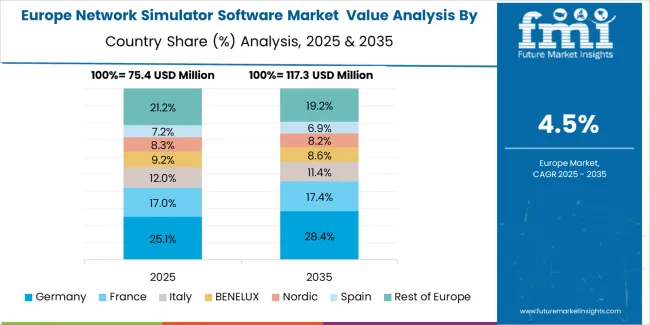
The Germany market leads in precision simulation technology based on integration with industrial systems and advanced engineering platforms for enhanced performance capabilities. The country shows strong potential with a CAGR of 5.8% through 2035, driven by the modernization of existing industrial infrastructure and the expansion of advanced manufacturing facilities in major technology regions, including Bavaria, Baden-Württemberg, North Rhine-Westphalia, and Lower Saxony. German companies are adopting intelligent network simulation systems for quality improvement and operational enhancement, particularly in regions with advanced industrial requirements and applications demanding comprehensive technology upgrades. Technology deployment channels through established engineering institutions and manufacturing operators expand coverage across production facilities and innovation-focused applications.
German market characteristics demonstrate sophisticated type utilization patterns, with leakage injection applications commanding 38.0% market share, reflecting the country's emphasis on comprehensive security testing and industrial network protection. Traffic generation solutions account for 32.0% market share, while other testing categories capture 30.0%, indicating balanced utilization across engineering and industrial sectors.
Leading market segments:
Brazil's market expansion is driven by diverse telecommunications demand, including infrastructure development in major cities and comprehensive network projects across multiple regions. The country demonstrates strong growth potential with a CAGR of 5.3% through 2035, supported by federal telecommunications programs and industry-level infrastructure development initiatives. Brazilian companies face implementation challenges related to technology complexity and integration requirements, requiring strategic development approaches and support from specialized simulation partners. Growing digital transformation demands and advanced network requirements create compelling business cases for simulation adoption, particularly in telecommunications areas where advanced testing capabilities have a direct impact on operational success and competitive positioning.
The Brazilian market exhibits distinctive characteristics with telecom and communications applications representing 40.0% market share, driven by the country's mobile network expansion and infrastructure modernization programs. Intelligent transportation applications account for 35.0% market share, reflecting significant smart city investments, while other applications capture 25.0% through various technology implementations.
Market characteristics:
USA network simulator software market demonstrates advanced implementation focused on network security optimization and enterprise performance enhancement, with documented integration of sophisticated simulation systems, achieving 42% improvement in testing efficiency across telecommunications and enterprise facilities. The country maintains steady growth momentum with a CAGR of 4.8% through 2035, driven by enterprise facilities' emphasis on security excellence and comprehensive testing methodologies that align with American technology standards applied to network simulation operations. Major technology markets, including California, Texas, New York, and Virginia, showcase advanced deployment of simulation platforms where testing systems integrate seamlessly with existing network infrastructure and comprehensive security management programs.
The USA market demonstrates balanced application distribution, with telecom and communications commanding 38.0% market share, enterprise applications accounting for 32.0%, and other applications capturing 30.0%. This distribution pattern reflects the country's diverse technology landscape and emphasis on both telecommunications infrastructure and enterprise network security requirements.
Key market characteristics:
UK's network simulator software market demonstrates established and innovation-focused landscape, characterized by growing integration of simulation technology with existing telecommunications infrastructure across network projects, service provider operations, and modernization initiatives. UK's emphasis on telecommunications excellence and technology innovation drives demand for advanced simulation solutions that support comprehensive infrastructure initiatives and testing requirements in network operations. The market benefits from partnerships between international simulation providers and domestic telecommunications leaders, creating service ecosystems that prioritize testing excellence and quality programs. Technology centers in major regions showcase developing simulation implementations where testing systems achieve efficiency improvements through integrated monitoring programs.
The UK market shows specialized characteristics with telecom and communications applications representing 41.0% market share, supported by the country's advanced telecommunications infrastructure and regulatory framework. Industrial applications account for 29.0% market share, while other applications capture 30.0% through diverse technology implementations across sectors.
Key market characteristics:
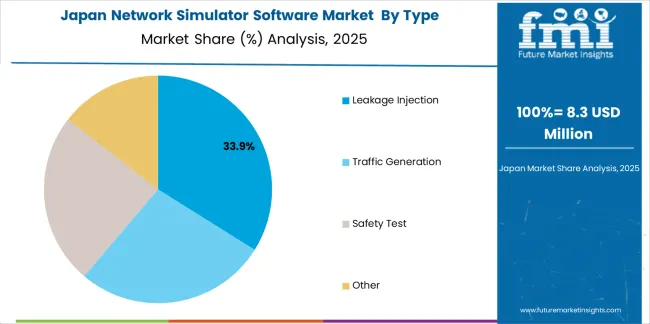
Japan's network simulator software market demonstrates advanced implementation focused on testing precision and technology performance optimization, with documented integration of specialized simulation systems, achieving 38% improvement in validation efficiency across telecommunications and technology facilities. The country maintains steady growth momentum with a CAGR of 3.8% through 2035, driven by technology facilities' emphasis on quality excellence and continuous operational methodologies that align with Japanese technology standards applied to network simulation operations. Major technology regions, including Kanto, Kansai, Chubu, and Kyushu, showcase advanced deployment of simulation platforms where testing systems integrate seamlessly with existing technology infrastructure and comprehensive quality management programs.
The Japanese market demonstrates sophisticated application patterns, with telecom and communications commanding 40.0% market share, industrial applications accounting for 35.0%, and other applications capturing 25.0%. This distribution reflects Japan's emphasis on precision technology applications and established telecommunications infrastructure requirements.
Key market characteristics:
The network simulator software market in Europe is projected to grow from USD 68.5 million in 2025 to USD 105.2 million by 2035, registering a CAGR of 4.4% over the forecast period. Germany is expected to maintain its leadership position with a 28.5% market share in 2025, projected to reach 29.1% by 2035, supported by its extensive industrial infrastructure, advanced engineering facilities, and comprehensive telecommunications networks serving major European markets.
United Kingdom follows with a 22.0% share in 2025, projected to reach 22.4% by 2035, driven by comprehensive telecommunications programs in major technology regions implementing advanced simulation systems. France holds an 18.0% share in 2025, expected to maintain 18.2% by 2035 through the ongoing development of technology facilities and telecommunications networks. Italy commands a 15.0% share, while Spain accounts for 12.0% in 2025. The Rest of Europe region is anticipated to maintain momentum at 4.5% by 2035, attributed to increasing simulation adoption in Nordic countries and emerging Eastern European technology facilities implementing network testing programs.
The Japanese network simulator software market demonstrates a mature and precision-oriented ecosystem, characterized by advanced integration of simulation technology with telecommunications infrastructure, industrial networks, and quality management systems across major technology and manufacturing regions. Japan’s emphasis on engineering accuracy and operational reliability drives sustained demand for high-precision simulation solutions that ensure consistent network validation and security compliance. The market benefits from strategic partnerships between international simulation vendors and domestic technology leaders, including established telecommunications, semiconductor, and industrial software companies, forming a comprehensive service ecosystem centered on performance optimization and quality assurance.
Simulation platforms in major industrial and research regions, Kanto, Kansai, Chubu, and Kyushu, demonstrate advanced deployment of AI-integrated testing systems where validation accuracy has improved by up to 38% through automated analysis and quality-driven simulation routines. Japanese companies prioritize long-term operational stability and regulatory compliance, supporting continuous upgrades to simulation capabilities across 5G, industrial automation, and precision engineering sectors. This structured and reliability-focused approach positions Japan as a benchmark market for precision-grade network simulation and validation systems.
The South Korean network simulator software market is characterized by a strong presence of international technology providers, who maintain leading positions through comprehensive system integration, advanced network testing, and specialized technical service models supporting both telecommunications and smart infrastructure applications. The market reflects a highly collaborative structure, where Korean defense and technology integrators partner with global simulation firms to develop customized, rapid-deployment solutions aligned with national 5G and intelligent transportation initiatives.
Key activity centers across Seoul, Daejeon, and Busan demonstrate strong adoption of cloud-based simulation systems that integrate with Korea’s advanced telecommunications backbone. Local technology specialists are expanding their market share by offering technical certification, simulation training, and system localization services, addressing growing demand for performance optimization and network resilience testing. The competitive landscape highlights hybrid service partnerships between multinational software developers and Korean system integrators, combining global simulation expertise with domestic innovation, language localization, and infrastructure management.
South Korea’s focus on digital infrastructure modernization and network performance assurance continues to drive simulation demand, positioning technology providers as key enablers of intelligent, high-speed telecommunications networks across industrial and government sectors.
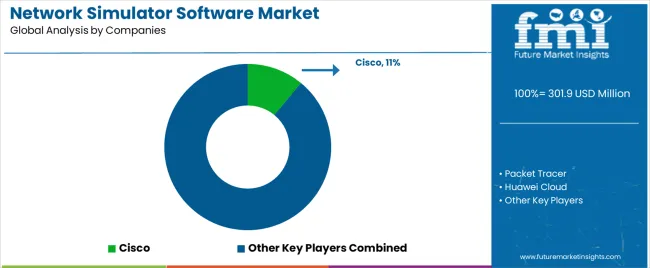
The network simulator software market features approximately 16-20 key players with moderate concentration, where the top three companies control roughly 40-50% of global market share through established software portfolios and extensive telecommunications industry relationships. Competition centers on simulation accuracy, feature capabilities, and technical expertise rather than price competition alone.
Market leaders include Cisco and Huawei Cloud, which maintain competitive advantages through comprehensive simulation portfolios, advanced testing capabilities, and deep expertise in the telecommunications and enterprise networking sectors, creating high switching costs for customers. These companies leverage established industry relationships and ongoing development partnerships to defend market positions while expanding into adjacent testing and validation applications. Cisco leads with 11% share owing to its diverse product capabilities.
Challengers encompass Juniper and vLabs, which compete through specialized simulation technologies and strong presence in key networking markets. Technology specialists, including Riverbed Technology, Tetcos, and Amazon AWS, focus on specific simulation applications or vertical markets, offering differentiated capabilities in cloud-based systems, academic applications, and enterprise-specific testing.
Cloud service providers and emerging simulation companies create competitive pressure through innovative platform approaches and rapid development capabilities, particularly in cloud-based testing markets where Microsoft Azure and Amazon AWS leverage their infrastructure advantages. Market dynamics favor companies that combine advanced simulation technologies with comprehensive support services that address the complete testing lifecycle from initial setup through ongoing performance monitoring and technical assistance.
| Items | Values |
|---|---|
| Quantitative Units (2025) | USD 301.9 million |
| Type | Leakage Injection, Traffic Generation, Safety Test, Other |
| Application | Telecom and Communications, Intelligent Transportation, Industrial, Other |
| Regions Covered | Asia Pacific, North America, Europe, Latin America, Middle East & Africa |
| Countries Covered | China, India, Germany, Brazil, USA, UK, Japan, and 40+ countries |
| Key Companies Profiled | Cisco, Huawei Cloud, Juniper, vLabs, Riverbed Technology, Tetcos, Amazon AWS, Microsoft Azure, Scalable Network Technologies, Apposite Technologies, MathWorks, AnyLogic, Keysight, Core Security |
| Additional Attributes | Dollar sales by type and application categories, regional adoption trends across Asia Pacific, North America, and Europe, competitive landscape with simulation providers and technology companies, platform requirements and specifications, integration with telecommunications initiatives and enterprise networks, innovations in simulation technology and testing systems, and development of specialized applications with security validation and performance optimization capabilities. |
The global network simulator software market is estimated to be valued at USD 301.9 million in 2025.
The market size for the network simulator software market is projected to reach USD 491.8 million by 2035.
The network simulator software market is expected to grow at a 5.0% CAGR between 2025 and 2035.
The key product types in network simulator software market are leakage injection, traffic generation, safety test and other.
In terms of application, telecom and communications segment to command 39.0% share in the network simulator software market in 2025.






Full Research Suite comprises of:
Market outlook & trends analysis
Interviews & case studies
Strategic recommendations
Vendor profiles & capabilities analysis
5-year forecasts
8 regions and 60+ country-level data splits
Market segment data splits
12 months of continuous data updates
DELIVERED AS:
PDF EXCEL ONLINE
Network Connectivity Tester Market Size and Share Forecast Outlook 2025 to 2035
Network Analyzers Market Size and Share Forecast Outlook 2025 to 2035
Network as a Service (NaaS) Market Size and Share Forecast Outlook 2025 to 2035
Network Analytics Market Size and Share Forecast Outlook 2025 to 2035
Network Devices Market Size and Share Forecast Outlook 2025 to 2035
Network Sandboxing Market Size and Share Forecast Outlook 2025 to 2035
Network Access Control (NAC) Market Size and Share Forecast Outlook 2025 to 2035
Network Monitoring Market Size and Share Forecast Outlook 2025 to 2035
Network Encryption Market Size and Share Forecast Outlook 2025 to 2035
Network Packet Broker Market Size and Share Forecast Outlook 2025 to 2035
Network Traffic Analytics Market Size and Share Forecast Outlook 2025 to 2035
Network Function Virtualization (NFV) Market Size and Share Forecast Outlook 2025 to 2035
Network Cable Tester Market Size and Share Forecast Outlook 2025 to 2035
Network Point-of-Care Glucose Testing Market Size and Share Forecast Outlook 2025 to 2035
Network Forensics Market Size and Share Forecast Outlook 2025 to 2035
Network Telemetry Market Size and Share Forecast Outlook 2025 to 2035
Network Security Policy Management Market Size and Share Forecast Outlook 2025 to 2035
Network Probe Market Size and Share Forecast Outlook 2025 to 2035
Network Traffic Analysis Solutions Market Size and Share Forecast Outlook 2025 to 2035
Network Slicing Market Size and Share Forecast Outlook 2025 to 2035

Thank you!
You will receive an email from our Business Development Manager. Please be sure to check your SPAM/JUNK folder too.
Chat With
MaRIA